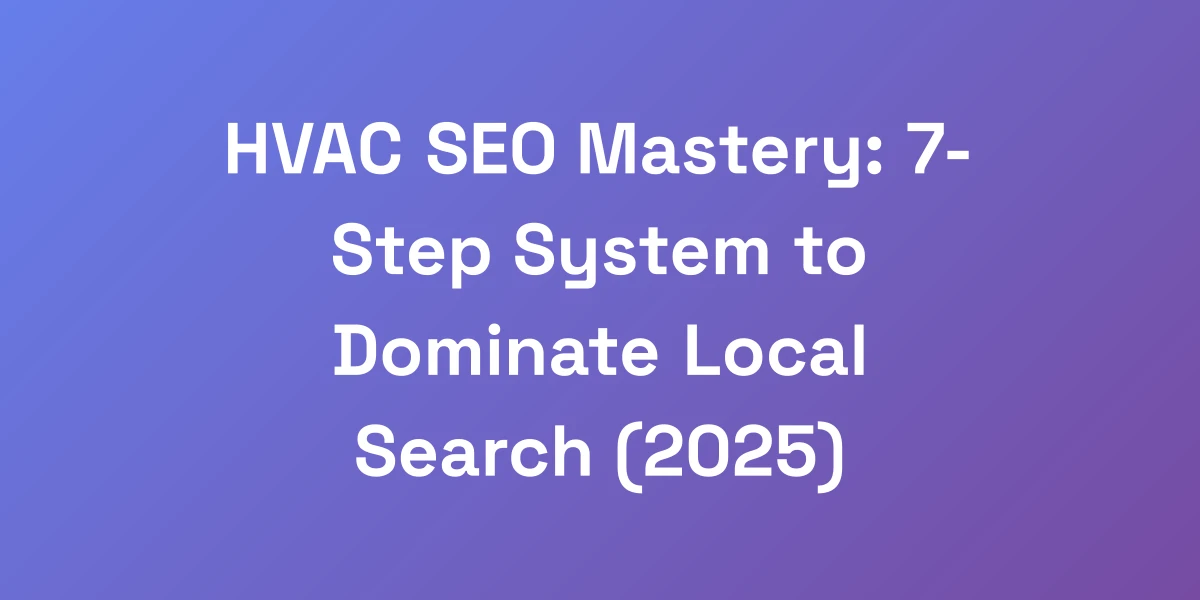
SEO for Contractors: 7-Step Blueprint to Dominate Local Search (2025)
Mar 25, 2025 | By [email protected]
Why Most Contractors Fail at SEO (And How to Win Instead)
Let me be direct: 90% of contractors are bleeding money by ignoring SEO or doing it wrong.
I’ve consulted with hundreds of construction businesses, and here’s the truth – your competitors are stealing your customers because they show up first in Google.
But here’s the game-changing reality: local SEO for contractors is simpler than you think.
The key is focusing on high-leverage activities that actually move the needle.
In this guide, we’re sharing the exact blueprint that’s generated millions in revenue for our contractor clients.
No fluff, just results.
The Real Cost of Ignoring Contractor SEO
Imagine pouring funds into marketing channels that don’t deliver tangible results. That’s what’s happening when contractors overlook SEO.
Without a robust SEO strategy, your online visibility remains minimal, causing potential clients to turn to competitors who have optimized their digital presence.
This isn’t just about missing out on leads; it’s about sustaining your business in a competitive market where digital presence dictates growth.
Consider this: 46% of all Google searches are local. Are you showing up when local clients are searching for your services?
Ignoring SEO means ignoring nearly half of your potential client base who are actively seeking contractors like you.
Common SEO Mistakes Killing Your Business
Many contractors dive into SEO without understanding its intricacies, leading to costly mistakes.
One prevalent error is targeting high-volume keywords without considering intent. These keywords often attract traffic that isn’t ready to convert into paying clients.
Another mistake is neglecting the optimization of your Google Business Profile. This is a goldmine for local visibility, yet many overlook its potential.
Additionally, poor website structure and slow loading times can drive away potential leads before they even see what you offer. Implementing AI-powered SEO automation tools can help streamline your website optimization efforts, ensuring faster load times and a better user experience.
Are you making these mistakes? Let’s ensure your SEO strategy isn’t one of them.
The Shift in Customer Search Behavior
Customer behavior has evolved, especially in how they search for services.
Today, clients prefer finding contractors online, comparing reviews, and checking portfolios before making a decision.
This shift emphasizes the need for a strong online presence. If your competitors are capitalizing on this shift, you risk falling behind.
Are you adapting to these changes, or are you stuck in outdated marketing practices?
Understanding and aligning with current search behaviors is crucial for attracting and retaining clients. Leveraging SEO freelancing services can provide the expertise you need to adapt effectively.
Understanding Your Digital Competition
Knowing who you’re up against in the digital arena is half the battle won.
Analyze your competitors’ online strategies: their keyword usage, content quality, and backlink profiles. This includes understanding startup SEO techniques that new entrants use to disrupt the market.
Identify gaps in their approach and find opportunities to outshine them. This isn’t about imitation; it’s about innovation.
Have you mapped out your digital competition? If not, you’re leaving money on the table.
Let’s delve into how to systematically analyze and outperform your online rivals.
Dominating Google Business Profile: Your First Money Move
Your Google Business Profile is the highest ROI asset you’re probably neglecting right now.
Here’s why it matters: 46% of all Google searches have local intent.
When someone searches for a contractor, they’re looking at the map pack first.
I’ve seen contractors double their leads in 30 days just by optimizing their GBP correctly.
The secret? It’s not just about claiming your profile – it’s about weaponizing it with the right content, photos, and review strategy that triggers Google ranking factors.
Step-by-Step GBP Optimization Checklist
- Claim and Verify Your Profile: Ensure your business is claimed and verified on Google.
- Complete Every Section: Fill out all information accurately, including business name, address, phone number, and hours.
- Choose Relevant Categories: Select primary and secondary categories that best represent your services.
- Add a Comprehensive Description: Craft a compelling description using your target keywords naturally.
- Utilize Attributes: Highlight specific attributes like “wheelchair accessible” or “free estimates” to attract specific client needs.
Photo Optimization Secrets
Visuals speak louder than words, especially in the contracting industry.
High-quality photos can significantly enhance your GBP, making it more appealing to potential clients.
Here’s how to optimize your photos:
- Use High-Resolution Images: Crisp, clear images reflect professionalism.
- Showcase Your Work: Include before-and-after photos of your projects to demonstrate expertise.
- Update Regularly: Keep your photo gallery fresh to signal ongoing activity and engagement.
- Geotag Your Photos: Include location data to strengthen local SEO signals.
Review Generation System
Reviews are the lifeblood of local SEO. They not only build trust but also influence your rankings.
Implement a systematic approach to generating reviews:
- Ask After Completion: Request reviews from satisfied clients immediately after project completion.
- Make It Easy: Provide direct links to your GBP review page.
- Respond Promptly: Engage with every review, showing appreciation or addressing concerns.
- Incentivize Feedback: Offer small incentives for honest reviews, ensuring compliance with Google’s guidelines.
Service Area Optimization
Defining your service area accurately can significantly boost your local SEO efforts.
Here’s how to optimize:
- Specify Locations: Clearly outline all the areas you serve in your GBP and website.
- Create Location Pages: Develop dedicated pages for each service area with localized content.
- Use Local Keywords: Incorporate city names and regional terms naturally within your content.
- Ensure Consistency: Maintain uniform business information across all platforms and directories.
Posts and Updates Strategy
Regular updates keep your GBP active and engage potential clients.
Effective strategies include:
- Share Project Updates: Post about ongoing or completed projects to showcase your work.
- Promote Special Offers: Highlight any discounts or promotions to incentivize inquiries.
- Announce Events: Inform your audience about any community events or open houses.
- Utilize Rich Media: Incorporate images, videos, and infographics to make your posts more engaging.
Website Optimization That Actually Converts
Stop wasting money on fancy websites that don’t convert.
Your contractor website needs one thing: to turn visitors into leads.
Period.
The problem? Most web designers don’t understand contractor businesses.
They build pretty sites that leak money faster than a broken pipe.
We’ll show you how to transform your website into a lead-generating machine using our proven C.A.L.L framework: Clarity, Authority, Lead capture, and Local optimization. Incorporating business blogging can further enhance your site’s authority and attract more leads.
This isn’t theory – it’s the exact system that’s generated over $100M in revenue for contractors.
The C.A.L.L Framework Explained
The C.A.L.L framework is designed to ensure every aspect of your website contributes to lead generation:
- Clarity: Ensure your message is clear and immediately tells visitors what you do and how you can help them.
- Authority: Establish your expertise through testimonials, certifications, and case studies.
- Lead Capture: Implement effective forms, calls-to-action, and contact options to capture visitor information.
- Local Optimization: Optimize your site with local keywords and content to attract regional clients.
Mobile-First Optimization
With the majority of local searches happening on mobile, a mobile-first approach is non-negotiable.
Ensure your website is responsive, loads quickly, and offers a seamless user experience across all devices.
- Responsive Design: Your site should adapt to various screen sizes without losing functionality.
- Fast Loading Times: Optimize images and use efficient coding practices to reduce load times.
- Easy Navigation: Simplify menu structures and ensure buttons are easily tappable.
- Optimized Forms: Make sure contact forms are mobile-friendly and easy to complete.
Speed Optimization Techniques
Website speed directly impacts user experience and SEO rankings.
Implement these techniques to boost speed:
- Compress Images: Use tools to reduce image sizes without compromising quality.
- Minimize HTTP Requests: Limit the number of elements on your page to decrease load times.
- Use Caching: Implement browser caching to speed up recurring visits.
- Optimize Code: Remove unnecessary code and use minification to enhance performance.
Local Landing Page Strategy
Create dedicated landing pages for each service area to target local searches effectively.
Here’s how:
- Unique Content: Ensure each landing page has distinct content tailored to the specific location.
- Local Keywords: Integrate location-specific keywords naturally throughout the content.
- Testimonials: Feature reviews and testimonials from clients in that particular area.
- Contact Information: Provide clear and accessible contact details for each service area.
Call-to-Action Placement
Strategically placing calls-to-action (CTAs) can drive conversions.
Effective placement includes:
- Above the Fold: Ensure primary CTAs are visible without scrolling.
- In Content: Embed CTAs within your content to capture interested leads.
- At the End of Pages: Encourage actions after conveying valuable information.
- Persistent CTAs: Use floating or sticky CTAs that remain visible as users navigate the site.
Trust Signal Integration
Building trust is essential for converting visitors into clients.
Integrate trust signals seamlessly:
- Customer Testimonials: Showcase positive feedback from satisfied clients.
- Certifications and Awards: Display any industry certifications or awards to establish credibility.
- Secure Website: Ensure your site uses HTTPS to protect user data and signal trustworthiness.
- Case Studies: Provide detailed case studies of past projects to highlight your expertise.
Keyword Research for Maximum ROI
Most SEO “experts” will tell you to target high-volume keywords. They’re wrong.
In the contractor space, intent beats volume every time.
We’ll show you how to find and target the exact keywords your ideal customers are using when they’re ready to hire.
We’re talking about keywords with buyer intent – the ones that actually put money in your pocket.
This isn’t about getting more traffic; it’s about getting the right traffic that converts into high-ticket projects.
High-Intent Keyword Research Process
Focusing on high-intent keywords ensures that the traffic you attract is more likely to convert.
- Identify Service-Specific Terms: Focus on keywords that specify the services you offer, such as “roof repair” or “emergency plumbing.”
- Analyze Search Intent: Determine what the searcher intends to achieve with their query.
- Use Tools Effectively: Leverage tools like Google Keyword Planner, SEMrush, or Ahrefs, and incorporate search engine optimization automation to uncover high-intent keywords efficiently.
- Prioritize Conversion Potential: Select keywords that signal readiness to hire, such as “hire a contractor near me.”
Local Keyword Opportunities
Local keywords are the cornerstone of effective local SEO for contractors.
Here’s how to uncover and utilize them:
- Incorporate Location Names: Use city or neighborhood names within your keywords, like “plumber in Stamford, CT.”
- Leverage Geographic Modifiers: Terms like “near me” or “closest” can enhance local relevance.
- Focus on Local Services: Tailor keywords to specific local services, such as “affordable roofing in New Castle, DE.”
- Analyze Competitor Keywords: Identify local keywords your competitors are ranking for and find opportunities to outshine them.
Competitor Keyword Analysis
Understanding what keywords your competitors are targeting can provide a strategic advantage.
Steps to perform effective competitor keyword analysis:
- Identify Top Competitors: Determine who your main online competitors are in your service areas.
- Use SEO Tools: Tools like SEMrush or Ahrefs can help you uncover the keywords your competitors are ranking for.
- Analyze Keyword Performance: Assess the performance and difficulty of each competitor keyword.
- Find Gaps: Identify keywords that your competitors are missing and capitalize on them.
Long-Tail Gold Mines
Long-tail keywords are less competitive and highly specific, making them invaluable for contractors.
Advantages include:
- Higher Conversion Rates: Their specificity attracts users ready to make a decision.
- Less Competition: Fewer businesses target these keywords, making it easier to rank higher.
- Better Content Alignment: Highly specific keywords allow for more targeted and relevant content creation.
- Examples:
- “Affordable roofing contractor in Austin”
- “Emergency plumber in Chicago”
Service-Based Keyword Mapping
Mapping your keywords to specific services ensures comprehensive coverage and relevance.
Here’s how:
- List Your Services: Create a detailed list of all the services you offer.
- Assign Relevant Keywords: Match each service with appropriate high-intent and local keywords.
- Optimize Service Pages: Ensure each service page is optimized for its assigned keywords.
- Monitor and Adjust: Regularly review the performance of your keywords and make adjustments as needed.
Conclusion
We’ve walked through the critical steps contractors need to dominate local search through effective SEO.
From optimizing your Google Business Profile to refining your keyword strategy, each element plays a vital role in driving leads and growing your business.
Remember, it’s not about chasing every potential client; it’s about attracting the right ones who are ready to hire you.
Implement these strategies with diligence, and watch your local presence—and revenue—soar.
Ready to transform your contractor business? Start applying these SEO tactics today and take the first step towards dominating your local market.
Have questions or success stories to share? Drop a comment below and let’s engage!








